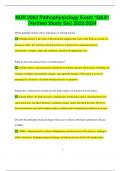Exam (elaborations)
NUR 2063 Pathophysiology Exam *Q&A* |Verified Study Set| 2025/2024
- Module
- Nurse 2o63
- Institution
- Nurse 2o63
NUR 2063 Pathophysiology Exam *Q&A* |Verified Study Set| 2025/2024 Define pathophysiology and its importance in nursing practice. Pathophysiology is the study of the functional changes that occur in the body as a result of a disease or injury. It is crucial in nursing practice as it helps n...
[Show more]



